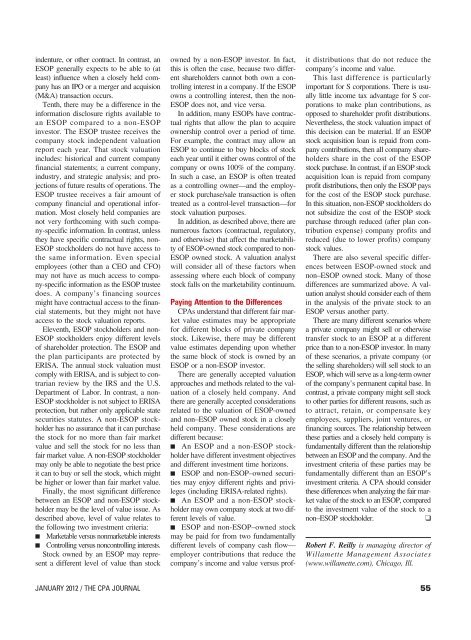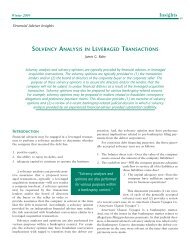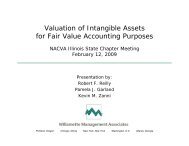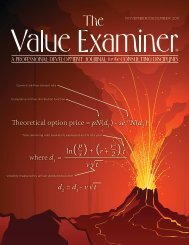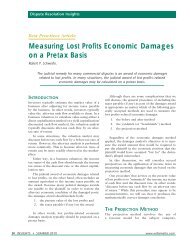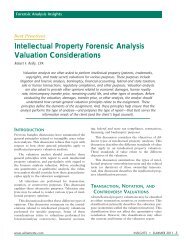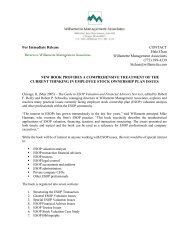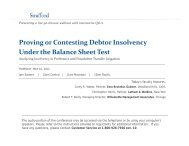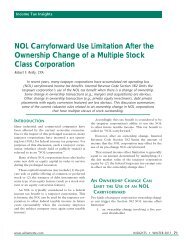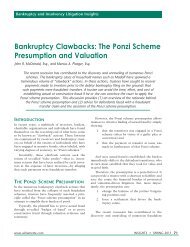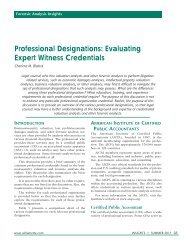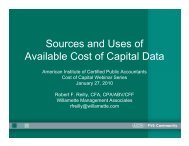View PDF - Willamette Management Associates
View PDF - Willamette Management Associates
View PDF - Willamette Management Associates
- No tags were found...
Create successful ePaper yourself
Turn your PDF publications into a flip-book with our unique Google optimized e-Paper software.
indenture, or other contract. In contrast, anESOP generally expects to be able to (atleast) influence when a closely held companyhas an IPO or a merger and acquision(M&A) transaction occurs.Tenth, there may be a difference in theinformation disclosure rights available toan ESOP compared to a non-ESOPinvestor. The ESOP trustee receives thecompany stock independent valuationreport each year. That stock valuationincludes: historical and current companyfinancial statements; a current company,industry, and strategic analysis; and projectionsof future results of operations. TheESOP trustee receives a fair amount ofcompany financial and operational information.Most closely held companies arenot very forthcoming with such company-specificinformation. In contrast, unlessthey have specific contractual rights, non-ESOP stockholders do not have access tothe same information. Even specialemployees (other than a CEO and CFO)may not have as much access to company-specificinformation as the ESOP trusteedoes. A company’s financing sourcesmight have contractual access to the financialstatements, but they might not haveaccess to the stock valuation reports.Eleventh, ESOP stockholders and non-ESOP stockholders enjoy different levelsof shareholder protection. The ESOP andthe plan participants are protected byERISA. The annual stock valuation mustcomply with ERISA, and is subject to contrarianreview by the IRS and the U.S.Department of Labor. In contrast, a non-ESOP stockholder is not subject to ERISAprotection, but rather only applicable statesecurities statutes. A non-ESOP stockholderhas no assurance that it can purchasethe stock for no more than fair marketvalue and sell the stock for no less thanfair market value. A non-ESOP stockholdermay only be able to negotiate the best priceit can to buy or sell the stock, which mightbe higher or lower than fair market value.Finally, the most significant differencebetween an ESOP and non-ESOP stockholdermay be the level of value issue. Asdescribed above, level of value relates tothe following two investment criteria:■ Marketable versus nonmarketable interests■ Controlling versus noncontrolling interests.Stock owned by an ESOP may representa different level of value than stockowned by a non-ESOP investor. In fact,this is often the case, because two differentshareholders cannot both own a controllinginterest in a company. If the ESOPowns a controlling interest, then the non-ESOP does not, and vice versa.In addition, many ESOPs have contractualrights that allow the plan to acquireownership control over a period of time.For example, the contract may allow anESOP to continue to buy blocks of stockeach year until it either owns control of thecompany or owns 100% of the company.In such a case, an ESOP is often treatedas a controlling owner—and the employerstock purchase/sale transaction is oftentreated as a control-level transaction—forstock valuation purposes.In addition, as described above, there arenumerous factors (contractual, regulatory,and otherwise) that affect the marketabilityof ESOP-owned stock compared to non-ESOP owned stock. A valuation analystwill consider all of these factors whenassessing where each block of companystock falls on the marketability continuum.Paying Attention to the DifferencesCPAs understand that different fair marketvalue estimates may be appropriatefor different blocks of private companystock. Likewise, there may be differentvalue estimates depending upon whetherthe same block of stock is owned by anESOP or a non-ESOP investor.There are generally accepted valuationapproaches and methods related to the valuationof a closely held company. Andthere are generally accepted considerationsrelated to the valuation of ESOP-ownedand non–ESOP owned stock in a closelyheld company. These considerations aredifferent because:■ An ESOP and a non-ESOP stockholderhave different investment objectivesand different investment time horizons.■ ESOP and non-ESOP–owned securitiesmay enjoy different rights and privileges(including ERISA-related rights).■ An ESOP and a non-ESOP stockholdermay own company stock at two differentlevels of value.■ ESOP and non-ESOP–owned stockmay be paid for from two fundamentallydifferent levels of company cash flow—employer contributions that reduce thecompany’s income and value versus profitdistributions that do not reduce thecompany’s income and value.This last difference is particularlyimportant for S corporations. There is usuallylittle income tax advantage for S corporationsto make plan contributions, asopposed to shareholder profit distributions.Nevertheless, the stock valuation impact ofthis decision can be material. If an ESOPstock acquisition loan is repaid from companycontributions, then all company shareholdersshare in the cost of the ESOPstock purchase. In contrast, if an ESOP stockacquisition loan is repaid from companyprofit distributions, then only the ESOP paysfor the cost of the ESOP stock purchase.In this situation, non-ESOP stockholders donot subsidize the cost of the ESOP stockpurchase through reduced (after plan contributionexpense) company profits andreduced (due to lower profits) companystock values.There are also several specific differencesbetween ESOP-owned stock andnon–ESOP owned stock. Many of thosedifferences are summarized above. A valuationanalyst should consider each of themin the analysis of the private stock to anESOP versus another party.There are many different scenarios wherea private company might sell or otherwisetransfer stock to an ESOP at a differentprice than to a non-ESOP investor. In manyof these scenarios, a private company (orthe selling shareholders) will sell stock to anESOP, which will serve as a long-term ownerof the company’s permanent capital base. Incontrast, a private company might sell stockto other parties for different reasons, such asto attract, retain, or compensate keyemployees, suppliers, joint ventures, orfinancing sources. The relationship betweenthese parties and a closely held company isfundamentally different than the relationshipbetween an ESOP and the company. And theinvestment criteria of these parties may befundamentally different than an ESOP’sinvestment criteria. A CPA should considerthese differences when analyzing the fair marketvalue of the stock to an ESOP, comparedto the investment value of the stock to anon–ESOP stockholder.❑Robert F. Reilly is managing director of<strong>Willamette</strong> <strong>Management</strong> <strong>Associates</strong>(www.willamette.com), Chicago, Ill.JANUARY 2012 / THE CPA JOURNAL55


